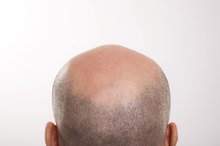What does fact checked mean?
At Healthfully, we strive to deliver objective content that is accurate and up-to-date. Our team periodically reviews articles in order to ensure content quality. The sources cited below consist of evidence from peer-reviewed journals, prominent medical organizations, academic associations, and government data.
The information contained on this site is for informational purposes only, and should not be used as a substitute for the advice of a professional health care provider. Please check with the appropriate physician regarding health questions and concerns. Although we strive to deliver accurate and up-to-date information, no guarantee to that effect is made.
Badly Infected Ingrown Hairs
Razor rash, razor bumps and ingrown hairs are common hazards associated with razor shaving among both men and women 3. According to MayoClinic.Com, changing your shaving techniques and using gentle exfoliation with a warm washcloth can tackle mild cases of ingrown hairs 3. However, when ingrown hairs become badly infected to the point where shaving is difficult or impossible, it may be time to see your doctor 3.
Folliculitis
Folliculitis is the medical term given to ingrown hairs that become infected with bacteria, resulting in tiny pimples filled with pockets of pus 23. The Staphylococcus aureus bacteria is the most common cause of folliculitis, although other bacteria, fungi and viruses can cause infected ingrown hairs 23. Folliculitis falls under one of two general categories, states MayoClinic.Com, superficial and deep 2. Superficial folliculitis umbrellas numerous other types of this condition 2. Staphylococcal folliculitis, also called barber's itch, presents as itchy, pus-filled papules that can erupt anywhere on your body where there are hair follicles 2. Endemic to the African-American population is pseudofolliculitis barbae, which affects men who shave. The tightly-curled hair follicles grow back into the skin, causing extensively inflamed follicles. This condition can ultimately lead to scarring on the face and neck.
- Folliculitis is the medical term given to ingrown hairs that become infected with bacteria, resulting in tiny pimples filled with pockets of pus 2.
Who Gets It
What Are the Red Bumps on My Inner Thigh Growing Around?
Learn More
According to MayoClinic.Com, folliculitis can be brought on by many things, including shaving and wearing tight clothing, as well as existing skin conditions like acne and dermatitis 2. Your risk of getting folliculitis increases if you have a medical condition that makes you less resistant to infection or if you use topical corticosteroids or antibiotic acne treatment 2. Exposure to heated water, such as a hot tub or swimming pool, puts you more at risk for folliculitis 2. This skin condition is also more common in people who are overweight, states MayoClinic.Com.
Self-Treatment
While bumps are present, applying hot, damp compresses to the infected area may encourage drainage, according to the National Institutes of Health 1. Badly infected ingrown hairs that cause conditions such as pseudofolliculitis barbae resolve if the beard or body hair is allowed to grow back out, states the American Osteopathic College of Dermatology, or AOCD, and this generally takes three to four weeks 3. Ingrown hairs may be reduced with proper shaving techniques, such as softening the beard with a warm washcloth, using a lubricating shaving gel and shaving in the direction of hair growth with only one stroke per section of skin 3. Alternately, using an electric razor or cream depilatories can cut down on ingrown hairs 3. Problematic is that many people with badly infected hair follicles don't allow them to heal before using another type of hair removal, says the AOCD.
Medical Treatment
Ingrown Hair in Nose
Learn More
When folliculitis is mild, it generally goes away without the need for medical treatment, states MayoClinic.Com 2. However, severe or persistent cases of folliculitis may necessitate the use of topical or oral antibiotic or antifungals, depending on the nature of the infection 2. If the severity of the follicuilitis results in the presence of a deep boil or carbunkle, your doctor may make a small incision on the skin and apply gauze to the infected site so pus can continue to drain.
Long-Term Prevention
If shaving is the cause of folliculitis, it might be beneficial to look into cosmetic treatments that get rid of the problem follicles on a long-term basis 2. Laser hair removal, which reduces hair density, and electrolysis, which permanently disables the ability of the hair to regrow, are two such options, says the AOCD. These treatments require you to make more than one visit, and they can also make a deep dent in your pocketbook. The AOCD indicates that there's only a small risk of scarring with these treatments.
- If shaving is the cause of folliculitis, it might be beneficial to look into cosmetic treatments that get rid of the problem follicles on a long-term basis 2.
Related Articles
References
- National Institutes of Health: Folliculitis
- Mayo Clinic: Folliculitis
- Mayo Clinic: Ingrown Hairs
- MedlinePlus. Acne.
- Cleveland Clinic. Ingrown hair. Updated February 28, 2018.
- Merck Manuals. Ingrown beard hairs. Updated October 2019.
- Cleveland Clinic. Ingrown hair: Management and treatment. Updated February 28, 2018.
- Ogunbiyi A. Pseudofolliculitis barbae; current treatment options. Clin Cosmet Investig Dermatol. 2019;12:241-247. doi:10.2147/CCID.S149250
- MedlinePlus. Folliculitis. Updated October 8, 2018.
- Zaenglein AL, Pathy AL, Schlosser BJ, Alikhan A, Baldwin HE, et. al. Guidelines of care for the management of acne vulgaris. Journal of the American Academy of Dermatology. 2016; 74(5): 945-73. doi:10.1016/j.jaad.2015.12.037
Writer Bio
Lisa Sefcik has been writing professionally since 1987. Her subject matter includes pet care, travel, consumer reviews, classical music and entertainment. She's worked as a policy analyst, news reporter and freelance writer/columnist for Cox Publications and numerous national print publications. Sefcik holds a paralegal certification as well as degrees in journalism and piano performance from the University of Texas at Austin.







